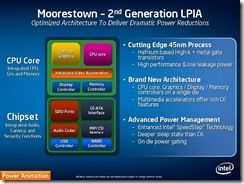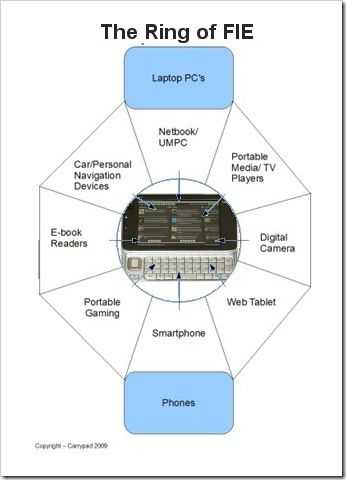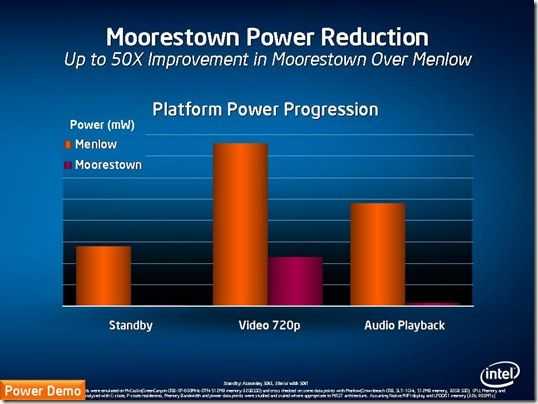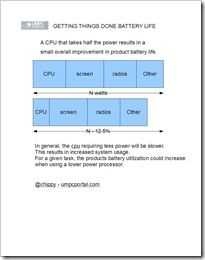 I wrote an update on Moorestown last week but I want to expand on that today because the new information we have now is extremely significant for the core audience here. Moorestown is the first computing platform that covers my definition of ultra mobile computing. From high-end smartphones, through targeted, Ultra Mobile ‘desktops’ , super-mobile laptops and the whole range of internet-connected opportunities that exist in the mobile internet space.
I wrote an update on Moorestown last week but I want to expand on that today because the new information we have now is extremely significant for the core audience here. Moorestown is the first computing platform that covers my definition of ultra mobile computing. From high-end smartphones, through targeted, Ultra Mobile ‘desktops’ , super-mobile laptops and the whole range of internet-connected opportunities that exist in the mobile internet space.
For those that are new to Intel’s low power ultra mobile products, Moorestown is the 2nd generation computing platform (not a CPU) that follows ‘Menlow’, the product you find in many MIDs and a number of netbooks. Moorestown is very small (about half the size of a credit card) and very power efficient. It uses an Atom CPU core and dedicated 3D and video hardware.
Firstly, let me summarise what we learnt about Moorestown from Intel last week.
- 50x less platform power usage in idle mode. In real world terms, multi-day idle.
- Intel states that Moorestown will enable far better smartbooks than on ARM-based products.
- Moblin V2 supports Moorestown but not Menlow. Menlow is seen as a ultra mobile PC (Windows OS) platform now. [UMPCs are back on the scene!]
- Moorestown can include voice-capable (GSM) software and hardware.
- Moblin V2 controls the Moorestown platform like no other operating system will be able to.
- The Atom core has been further refined for efficiency. (The core Atom architecture stays the same)
- Windows products will run on a ‘version’ of Moorestown but Menlow is still the focus for Windows products through 2009 and 2010
- Running Windows on (the Windows-compatible) version of Moorestown will not bring your the power efficiencies that Moblin will.
- All-day battery life is here.
- Moorestown supports 720p video recording.
- Moorestown supports 1080p playback.
- It might come earlier than expected (based on the advanced-stage products that were demonstrated, end of 2009 seems highly likely.)
- We have no idea about versions, SKU’s or CPU clock-rates.

My interpretation of what I saw is that Intel is now in all of the ‘full internet experience’ (FIE) markets with Moorestown. Smartphone, superphone, smartbook, netbook, mid, carpc, ebook readers, umpc, gaming, pnd and pmp. It matches the ring of FIE (image above)
Let me highlight three of the new segments.
Smartphone
Expect Moorestown-based devices to be as small as a smartphone and to be able to run, on a smartphone sized battery, for over 24 hours. Intel are telling us that devices will idle with 50x less power drain than today’s Intel Mobile Internet Devices. The worst MID I ever tested ticked-over for about 1 hour on the juice of a smartphone-sized battery. Intel says that this will increase to 50 hours. The best-case scenario, based on testing I’ve done on the current best-of-Intel is 3-times that figure. 3-days active standby.
Smartbook
Moorestown scales. It sleeps with one eye open but when it wakes up it’s capable of Internet browsing speeds, accuracy and richness that you will have never seen on an ARM-based device. I’m expecting high-end versions of Moorestown to bring sub 10-second average page loads to every web page on the Internet. The current best smartphones take twice as long as that and the next-gen may only shave 50% off that. Moblin goes head-to-head with Android and Maemo here and could even challenge Windows Mobile products.
Mobile Creativity / Microblogging / Social networking
I really wish Intel had highlighted HD video recording as it’s an important benchmark figure these days. Smartphone manufacturers are building these facilities into their devices and HD video is a huge growth area on the Internet. Moorestown enables 720p video recording. Not only that but the software layer has been designed with that in mind too. GPS-enabled applications with social-networking capabilities are baked into the software making it easy to make compelling mobile applications. Moorestown should enable you to get more creative, quicker. [continued on next page…]
Naturally for MIDs and UMPCs there are also some nice improvements. A Moblin-based MID is likely to return 2x battery life under average usage scenarios meaning that we’re up to 10 or more hours of in-use battery life.

Taking data I have from Menlow based platforms I can add real world figures to that diagram. For standby, the slide shows negligable power drain. For 720p video playback, 2W overall power consumption and for audio playback (screen off) it’s showing about 200mw. In real-terms, with very pocketable devices, you’re looking at multiple day audio playback and standby and 4hr 720p playback. Note that these are probably best-case figures and again, only my interpretation based on my work with many Menlow-based devices.
I’ve had time to chew over one more, less obvious features of Moorestown since last week and I’m calling it ‘Getting Things Done Battery Life.‘
The days of idle smartphones are long gone. People don’t let their devices idle for long and if you push your device to the limit, you’re in a sub-4hr usage bracket and not a multi-day standby bracket. iPhone users at South By South West this year were a classic example’ there were more iPhones connected to power outlets than laptops!
Standby battery life is no longer an important benchmark but idle power is still extremely important. Especially if you have a powerful platform that gets to idle more quickly than other platforms.
 In general, the slower the platform, the more time the device spends with the screen on, with the CPU working hard, with the radios out of standby and the memory, busses and storage awake. ‘Hurry Up and Get Idle’ is the expression that Intel use to highlight their advantage in this area and it deserves some thought because, apart from it being demonstrated live on stage at Computex, it’s something that we ultra mobile PC users have been aware of for some time. When you are mobile, time is important.
In general, the slower the platform, the more time the device spends with the screen on, with the CPU working hard, with the radios out of standby and the memory, busses and storage awake. ‘Hurry Up and Get Idle’ is the expression that Intel use to highlight their advantage in this area and it deserves some thought because, apart from it being demonstrated live on stage at Computex, it’s something that we ultra mobile PC users have been aware of for some time. When you are mobile, time is important.
Imagine a simple web page. You take your device out of standby, the screen comes on and you type the URL. At that point the memory, radios, data bus, storage and CPU all wake up and start consuming many times more power than they do in standby. A device could go from 100mw in standby to 2W when loading a web page. That’s a 20x power drain increase. It’s not difficult to imagine that a device that takes 7 seconds to load the page with a total power drain of 2W, uses LESS power than a system that take 15 seconds with a power-drain of 1.5W. Over that 15 second period however, the faster device needs to get to very low idle levels to capitalise on the advantage. The same applies if you’ve got background applications running. The faster you can do it, the quicker the device can go back to idle.
The principle of ‘Hurry Up Get Idle’ does require specialised software though and that’s where Moblin comes in. It’s been designed from the ground-up to be able to control the Moorestown platform like no other operating system will be able to. Here’s a video I took in the Ultra Mobility event that shows Intel demonstrating Moorestown platform power.
You can see the full presentation in much higher quality at the Intel website.
There’s one important issue with all this fast processing. When you’ve got it, you use it! A 5-minute waiting line is always a 5-minute waiting line and you will browse until you get to the cashier. The other issue to consider is that some people aren’t worried about getting things done quickly. They would rather have a cool device with cool software. Moblin and the OEMs have to tackle this problem but to me, it looks like they’ve already taken it into consideration.



Finally, it has to be said that if you’re the fastest, other people are going to look towards you. As either a user or manufacturer, setting a new benchmark bring you kudos. The user becomes satisfied. The OEM gets valuable eyeballs.
Summary
Moorestown dips into the smartphone segment and brings voice and a new level of processing power to that sector. It also introduces new levels of platform power control. Moblin will be able to take advantage of this like no other pc/software combination before it or even after it. Microsoft will struggle to get the best out of Moorestown and it’s possible that the early platform won’t even support Microsoft OS’. Intel have clearly stated that you won’t see the power efficiencies with Windows that you do with Moblin. [The fact that Intel has an x86 platform that isn’t Windows-friendly is worth discussing!]
The platform extends up out of the smartphone segment all the way up to the thin and light netbook segment. Moblin too. It goes head-to-head with Android although in this case, the software has been designed from the ground up for both of these segments. It remains to be seen how Android scales to netbooks or ‘smartbooks.’
Intel have a real selling point if their devices are noticeably quicker but they aren’t down to the efficiencies of ARM-based solutions yet and they don’t have any brand awareness or any products in the market yet. They aren’t moving to enable an app-store either which means there are no financial incentives for private or hobby software developers. [Note that Canonical, the company that runs Ubuntu, are working on, and have demonstrated, an Android application runtime module for MoblinV2]
Intel need a Tier One brand to get the product out into the market and they need to do it relatively quickly because the first ARM Cortex core devices are arriving and a lot of money is going into creating ARM-based platforms that also range from smartphone to smartbook. Computex 2009 highlighted that all the eyes are on ARM products and that their ecosystem has a huge momentum. Fortunately for Intel, the press are fickle. If they see something new and better, they’ll be happy to report on it so it’s up to Intel now to make a huge splash with a high-value brand using Moorestown to set a new benchmark in mobile computing. That might happen at IDF in September. If not it has to happen at CES in Jan 2010.
Full disclosure: I was at Computex as a guest of Intel.











New article: Intel’s Moorestown Platform. From Smartphone Through Smartbook and Beyond. http://cli.gs/Q9rhV7
All sounds great, although they would claim they are better than Arm….
I carry various forms of extra power for my iPhone when I travel to ensure I’m never short.
Hopefully that should change this week and I’ll see how much my first business with my new MID effects my smartphone battery life (meaning will I use it instead of the instant convenience of my phone?).
ARM is really not that far away power-wise compared to x86. At the moment they have the advantage because they have already invested in the ecosystem and the platform for lowering power consumption. SoCs are one of them. x86 has yet to get there. The largest contributors will be process technology differences and target performance.
That said, the Moorestown presentation compared a 600MHz Lincroft CPU and a ~1GHz level Silverthorne CPU for power consumption purposes. There was another presentation earlier that said 30% better experience/performance compared to Menlow.
I think the thing to take here is the base SKUs won’t be lowering power that much(compare Atom Z530 to A110 for example), but it will still be lower, and it’ll have a per-clock advantage thanks to the integrated memory controller. On another end of the scale, we’ll have probably 600MHz Lincroft CPUs that perform similar to Z500 but consume significantly less power.
Thanks for review, Chippy. It was interesting. There’s two questions – the price of a unit compared to ARM solutions and the meaning of x86 support under the non-Windows OS.
The price is likely to be higher to start with simply because smartphones on Moorestown will be premium devices. Slightly bigger. Targeted at early adopters. Business. etc.
As for your second question, I don’t really understand it. X86 support for non windows means it will only support Moblin OS first and then Windows later. Moblin is high highly tailored to get the best out of the initial Moorestown platform.
I guess they are forced to make a WIndows-capable version so that they don’t face anti-competitive claims.
As I understand it’s already Windows capable in term of working, but at least standard Windows ACPI driver won’t distribute power saving features which are the main benefits. If Intel only needs to make new ACPI driver than it’s ok, but Windows have some persistent background activity caused by different programs and services which also can be an obstacle to reach normal power saving. Actually I’m not a specialist in this so maybe I’m wrong…